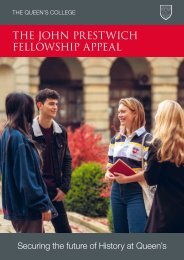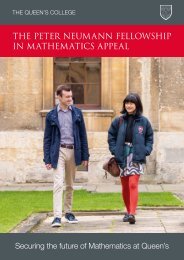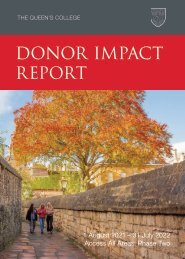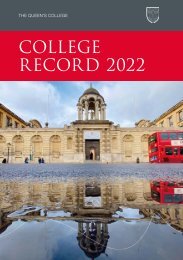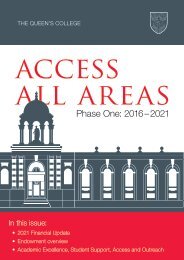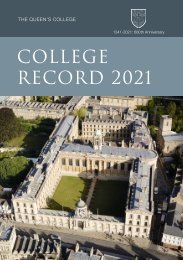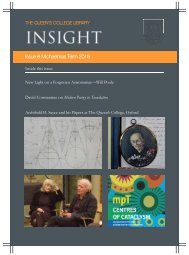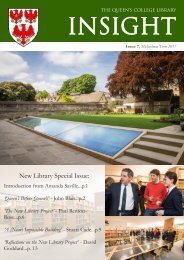The Queen's College Record 2023
Create successful ePaper yourself
Turn your PDF publications into a flip-book with our unique Google optimized e-Paper software.
Reports and <strong>College</strong> Activities<br />
is called the Standard Model of Particle Physics and is much like a periodic table for<br />
elementary particles. Notably, it has been surprisingly successful in the sense that<br />
within the realm of particle physics observables it has yet to encounter any robust<br />
discrepancies from theoretical prediction.<br />
On the other hand, the Standard Model has a number of theoretical deficiencies,<br />
for instance its structure is not understood (unlike the periodic table of elements).<br />
Moreover, observations of our universe reveal that there is seemingly some unknown<br />
class of particles (or macroscopic bodies) that cannot be understood within the<br />
Standard Model, so called “dark matter”. <strong>The</strong> best evidence for dark matter comes<br />
from the observation that many galaxies would behave quite differently if they didn’t<br />
have sizeable populations of invisible objects to source new gravitational attraction.<br />
Little is known about this hypothetical dark matter, but certainly they must not<br />
interact very significantly with regular particles, or we would be able to observe them<br />
directly or produce them in the lab.<br />
With so few observational handles, there are a myriad of possibilities for the nature of<br />
dark matter. For instance, one might ask if they could be related to other theoretical<br />
deficiencies of the Standard Model? Perhaps small black holes with masses<br />
much less than our Sun could be the dark matter, or contribute to the observed<br />
phenomenon? It is then important to ask what the observable consequences would<br />
be for each scenario. Most recently my collaborators and I have been thinking about<br />
how dark matter particles may convert to regular “visible” particles around small<br />
black holes. We have also been considering how the orbits of exoplanets might be<br />
tilted or deformed to eclipses if a small black hole flew close to the parent star. <strong>The</strong><br />
aim of such research is to identify new possibilities for discerning the nature of dark<br />
matter, and thus answering one of the most fundamental questions regarding the<br />
make-up of our universe.<br />
One of the most enjoyable aspects of my time in Oxford was interacting with the<br />
brilliant students. Indeed, I was delighted to get the opportunity to start an ongoing<br />
collaboration with one graduate student. It is always apparent that many of the Oxford<br />
students will doubtlessly go on to achieve great things and perhaps even become<br />
future leaders in my field. I will take these experiences and new collaborations formed<br />
at Queen’s <strong>College</strong> back to my home university and they will no doubt enrich my<br />
research program for years to come.<br />
24 <strong>The</strong> Queen’s <strong>College</strong> | <strong>College</strong> <strong>Record</strong> <strong>2023</strong>









